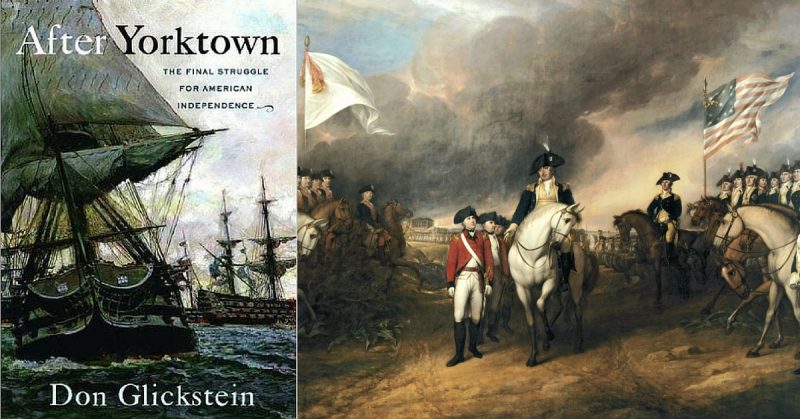The Battle of Yorktown is often grossly misrepresented in American textbooks. The narrative goes something like this: Cornwallis surrendered at the Battle of Yorktown and then the Treaty of Paris was signed, ending the Revolutionary War. Yet this misunderstanding is not limited to those attending schools. Many college students and adults who are surprised to learn the war continued another two years following Cornwallis’ surrender in Virginia. This misconception is precisely why Don Glickstein’s After Yorktown: The Final Struggle for American Independence is so needed. This masterful work provides clarity by examining what happened in the often-neglected final 18 months of the Revolutionary War.
Glickstein, a journalist based in New Jersey, makes one thing certain: for both the British and the Continentals, Cornwallis’ defeat at Yorktown in no way terminated the war. Upon hearing the news, John Adams remarked: “The English must have many more humiliations before they will agree to meet up upon equal terms…” General Washington himself feared that Congress “may think our work too nearly closed, and fall into a state of languor and relaxation…” Despite what we’ve learned in school, the British surrender at Yorktown did not make the Treaty of Paris inevitable. In fact, after Yorktown, the war expanded to four other continents.
After Yorktown captures the geographic breadth of the late Revolutionary War, showing that it was very much a world war – another fact that is understated in the traditional American narrative. The chapters are organized into eight parts based on theme and geographic location. There is part on the Frontier, the South, the Caribbean, the Mediterranean, even on fighting in India. The book is highly illuminating. Only specialists are likely to know of fighting in Guatemala or the French captain sent on a “secret mission to the Artic.” The book is also highly accessible. Most chapters are fairly short—some only a few pages. This is a book that can be enjoyed bit by bit over a long period of time without the reader losing sight of the big picture. It also helps that is well written.
Glickstein’s micro-biographies are another highlight. He does an excellent job of providing context and background to figures such as the “Swamp Fox” Francis Marion, “Bloody Bill” Cunningham, Colonel John Sevier, and others on both sides of the conflict. In providing context, he proves himself a master of making obscure connections. For example, he explains how Lt. Charles O’Hara became the only British general to surrender to both Washington and (years later) Napoleon. Connections are also made with seemingly unrelated figures such as Charles Darwin, Eli Whitney, and others. In the case of Francis Marion, Glickstein challenges the narrative of the “Swamp Fox” as a nearly invincible leader, and shows how his reputation has become mythologized. All throughout the book, Glickstein plays the role of myth-buster.
In the same way that he presents the war in a broad scope, Glickstein recognizes the broad spectrum of parties involved. In the final two years of the war, diverse groups played an ever-increasingly large role in hostilities. From the Cherokee in the South to African slaves in the Caribbean to dislocated Loyalists spread across the globe, a complex cast of participants is shown. A generous littering of anecdotal stories bring to life the book’s characters.
After Yorktown is a thoroughly researched 432 page volume. It is drawn heavily from both American and European primary sources. Glickstein’s thesis that American victory was only made secure when the British were forced to wage war across all corners of the globe is well supported. This book succeeds in all its aims and is recommended for generalists and specialists alike—it is broad enough to appeal to anyone with an interest in the American Revolution. While it would be a stretch to consider this book “revisionist,” it is a vital corrective addition to the body of Revolutionary War literature. This book provides a fuller and clearer picture how the Revolutionary War was won.

Reviewed by Nate Sullivan for War History Online
AFTER YORKTOWN: THE FINAL STRUGGLE FOR AMERICAN INDEPENDENCE
By Don Glickstein
Westholme Publishing, LLC
ISBN-10: 1-594-16233-6
ISBN-13: 9781594162336
